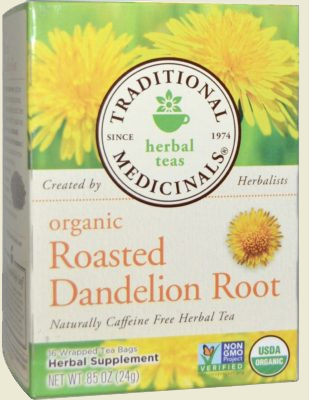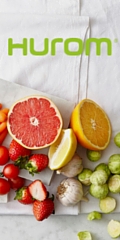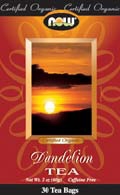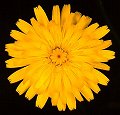A healing herb, dandelion contains a rich abundance of calcium, which constitutes fifty percent—or more—of the mineral elements in a human body. Concentrated in bones and teeth, this macronutrient is essential in blood and muscles. A one hundred fifty-pound person has approximately three pounds of this mineral. Calcium works together with Vitamin D to make dense, strong bones. High in calcium, ounce for ounce more than milk, and with a wealth of other nutrients, dandelion makes a long-time favorite choice for tea.
Dandelion is also loaded with calcium in the form of healthy mineral salts, which quickly alkalinize acidic blood. The rich combinations of calcium potassium salts in dandelion chemically “strip” harmful bacilli from moist mucosal tissue in the lungs; compounds in dandelion leaves (xanthophyll and lutein) help disinfect the lungs, making it much harder for toxic bacilli bacteria to remain there. The enormous vitamin A and calcium content in dandelion acts as an effective antibiotic and minimizes any viral activity by boosting immune defenses. Immune cells in a healthy person become active upon detection of intruders, like foreign microbes, and a rush of calcium ions activate the immune cells.
Dandelion has all the nutritive salts (bicarbonate, calcium, chloride, magnesium, potassium, phosphate, and sodium electrolytes); these help purify the blood and destroy excess acid. These natural ionic compounds are important to sustain life because mineral salts comprise part of every fluid and structure in the human body.
To make your own tea, read How to Pick Dandelions for Dandelion Tea; use six dandelion leaves per teacup. Tear the leaves into strips and drop them into the bottom of the cup, fill with boiling water, and let stand for 5-10 minutes. Strain if desired, and sweeten, if you wish, by stirring in a teaspoon of honey or sugar.
Unsweetened cooled dandelion tea makes an effective skin wash, applied to minor scars and inflammations.
Drinking dandelion tea can give the body a “natural high” or incredible sensation of energy, giving a “grounded” type of energy without unwanted side effects like from caffeine, calcium that helps keep your energy levels high!
Dandelions are a dark leafy green with wonderful roots, a very rich source of vitamins and minerals. This herbal chai also makes a delicious hot or iced latte! Follow the enticing fragrant bouquet with your nose – feel potent health benefits right to your toes.
Simmer 8 to 10 minutes over medium heat:
2 c. water
3 Tblsp. roasted dandelion root, or 3 dandelion roasted root tea bags
pinch cinnamon (or, a cinnamon stick)
ginger root (ground, or, even better, chopped, with skin)
and add your choice of:
• (anise seed)
• (bay leaf)
• (black peppercorns)
• ([green] cardamom seeds, crush slightly)
• (cloves)
• (orange peel, dried)
• (raspberry leaf, dried)
• (fennel seeds)
• (peppercorns)
• (star anise)
• (vanilla bean)
• (licorice root)
Strain the tea using a fine filter. To this add:
honey, a spoonful
(soy) milk, to taste
Heat again on a low flame, and do not boil.
Enjoy iced, or as a hot beverage.
Go all out for Spiced Dandelion Tea! Starting with a quart of water, simmer all but the dandelion, honey, and milk for 45 minutes, uncovered, add the dandelion, and then simmer another 15 minutes. Strain, sweeten, add milk, and serve.
Dandelion Sun Tea is a popular way to brew tea, a drinkable form of enjoying fabulously famous healthy raw foods. You get the great benefits that dandelion tea offers for cleansing your system, without heating your kitchen! A nifty method to harness the energy of the sun and make a zero-calorie beverage:
Dandelion Sun Tea
(Sunlight is not necessary… you can make this tea in the refrigerator, too!)
4-6 dandelion tea bags (or loose tea, or clean fresh plants)
1 quart water
Select a 2-quart glass container scrubbed in warm, soapy water. [As an extra precaution against bacteria found in tap water that can turn up in sun tea, dip the container into a weak solution of 1½ teaspoons (or up to 1 tablespoon) bleach to a gallon of water.] Add the water and the dandelion tea bags (or, loose tea); cover. Put in a place where sunlight will shine on the container 3 hours—4 maximum—moving the container if necessary to keep it in the sun. When the tea reaches the strength and flavor you like, it is ready (as it is not steaming hot, you may like it iced). Refrigerate leftovers, with or without removing the tea bags — as you like. Drink within a day.
You may find the taste of sun tea more mellow than tea steeped in water brought to a boil: boiling affects water acidity, and slow seeping coaxes out a slightly different flavor. You might garnish with a sprig of fresh mint, maybe sweeten.
It is possible gentle warmth may brew more than sun tea: warm tap water can facilitate a marvelous medium for microbes (Alcaligenes viscolactis). Discard cloudy, thick, or syrupy sun-brewed tea; bacteria tendrils form ropy strands.
Add a cinnamon stick, whole cloves, and perhaps pepper, if you please, at the start; dandelion properties also provide awesome anti-bacterial power, including inhibiting bacteria growth. With Dandelion Chai – Spiced Dandelion Root Tea you get your wonderful health benefits and a welcome chai spice flavor.
If using fresh plants, see How to Pick Dandelions for Dandelion Tea.
Form English (or Australian!) words from “dandelion tea”? Use no abbreviations, no proper nouns or pronouns, no improper words, no informal alternate spellings (like nite for night), and no slang. All the letters, organized for your convenience:
consonants: d d l n n t vowels: a a e e i o
How many words can you make in 1 minute? Take the challenge & play! Answers:
A A: a (ad) add addle ade aid aided ail ailed ale alit alone alto an anal and annal anneal anoint anointed anon ant ante anti at ate atone atoned
D D: dale dandelion dead deaden deal dealed deed del [vector differential operator] (deli) delta deltoid den denote denoted dent dental dented dentin dial dialed did die died diel diet dit dite dited dine dined do doe don donate donated done donned dot dote doted dude [ranch] dun dune
E E: eat eaten edit edited eel el elated elation eld elite ell end ended entail entailed eon
I: id ide [fish] idea ideal idle idled in inane indeed indolent inlet inn innate ion iota it
L: lad laden laid lanate land landed lane laned late lateen latin lead leaded led lei lend lended lent let lid lie lied linden line lined lint lion lit load loan loaned lode loden loin lone lot lotion lotioned
N N: nada nail nailed nat nation national neat neaten need neon net nil nit no nod node noel non none not note noted
O: oat odd ode oil oiled oint old olden (oleo) on one
T: tad tail tailed tale talon tan tanned tea teal te [note] ted tee teed teen teil [tree] ten tend tendon tenet ti [note] tiddle tide tided tidal tilde tile tiled tin tine tined tinned toad toddle toil toiled told ton tonal tone toned tonned
Try making a sentence—or phrase—or two, if you like!
It landed and no one noted it. … a tail on a lion … a dial tone...
Phrases using each dandelion-tea letter once: nation dealed; national deed…
We hope you add to our dandelion-tea word game and welcome your comments!
Eighth Most Wanted WHAT? Summer Brew! Whew! The news reports that Fantôme Pissenlit, from Belgium, is actually a very good beer. I personally would not know, although I loved visiting Belgium; I do not drink beer, but my husband does—ask him! Why beer on a tea site? This beer is made from… you guessed it! …dandelion tea!!!
In a Jul 15, 2009 post in Inventor Spot, Serious Fun for the Inventor in All of Us, “Don’t let the fact that dandelion tea is the basis for the Pissenlit, which is usually made with barley malt and hops. ( ‘Pissenlit’ means ‘piss in the bed’ in French, and uncooked dandelions are said to have a diuretic effect.) A peppy Belgian brew that pours amber, the flavor is described as acidic or very citric, depending on the reviewer. Orange makes a strong appearance as does spice.”
Come springtime, workers get to harvesting bushels of dandelions from the fields around the scenic farmhouse brewery. They remove the yellow flowers to dry in the sun, and then soak them a few days in water. They ferment the thick, dark dandelion “tea” and transform it into Pissenlit, a traditional drink also made from barley malt and hops. The result resembles a classic saison ale: golden and spritzy, strong and flavorful, having a distinctive hop bite. Even if it’s a strain to taste the brewed dandelion tea, it’s definitely in there in the bottles.
Gives a whole new meaning to “tea time”!
Beer is a beverage imbibed countless thousands of years. Noteworthy side effects can include addiction to alcohol; as always, keep on the proper side of the law, and concerning participating in this popular pastime, proceed at your own risk.
Ruth’s Dandelion Tea Haiku
Haiku, a Japanese-style poem:
5 syllables
7 syllables
5 syllables.
Dandelion Tea
Sunny thoughts, anchored deeply—
… invigorating.
I wanted a cup of dandelion tea. Sounded sweet and simple, until I wondered if I preferred tea made from the blossoms, leaves, or roots—the roots roasted, or not.
Reminded me of the foreigner arriving in New York City, not knowing a word of English, getting hungry. He formulated a plan: follow someone into a restaurant, and if what they ordered looked good, try ordering the same thing himself. Things went quite well, as he listened to the folks ahead of him order bean soup; it looked appetizing, and smelled good. “What will you have?” “Bea-n Sou-p, pl-ease!” He enjoyed eating it that meal… and ordered it the next meal, and the next. Now he wanted anything but bean soup. He got in line, unknowingly behind regulars — who placed a ham sandwich order. He didn’t understand a word anyone said, and waited to see what showed up. The sandwich looked very appetizing, and a whole lot different from bean soup. When it was his turn, he repeated in his best English, “Ha-m Sa-nd-wi-ch, please!” “Plain or rye?” “…??? … ??? … … Bea-n Sou-p, please.”
Blossoms? Leaves?? Or, roots??? Well, I made dandelion tea using the whole plant!
What common denominator links memory, mood, and learning—ah, yes, what does dandelion have a lot of, great for your memory? Great for your mood? And great for you, to learn?
Phrased precisely, what is dandelion high in that your body converts to acetylcholine, a neurotransmitter both in the peripheral nervous system and in the central nervous system, important in the brain for learning, mood, and memory? (Acetylcholine is low in people who have Alzheimer’s disease.)
Lecithin! This unique phospholipid—the main constituent being phosphatidyl choline—is a nutrient compound that emulsifies fat, lowers cholesterol, and protects the cardiovascular system. Dandelion is rich in this lipid, containing about 30,000 parts per million, nearly twice that of soybeans. Dandelion’s high content of lecithin, with its fat emulsifying properties, also makes it an effective digestive aid.
The important transmitter in the brain at nerve-to-nerve synapses, acetylcholine, uses another component:
Choline! Dandelion’s high concentration of choline and lecithin convert to acetylcholine. In the central nervous system, the resulting variety of effects as a neuromodulator include plasticity, excitability, arousal and reward.
Oh, another physiological function of the acetylcholine that dandelion helps your body make is particularly important: stimulation of muscle tissue.
Acetylcholine! Remember that… your brain is like a muscle! “Use it or lose it!”
In making “uplifting memories” drinking dandelion tea, there’s a lot to learn!



